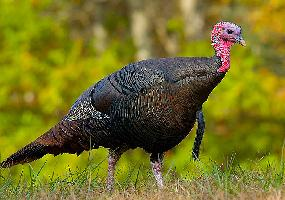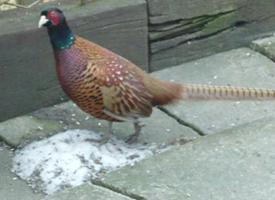
Greutăți și măsuri
| Înălțime la greabăn | 120 cm |
|---|---|
| Greutate | 10 kg |
| Viteză | 10 km/h |
Date biologice
| Durata de viață | 12 r |
|---|
Descrierea animalului
The turkey, belonging to the genus Meleagris, is a large bird native to the forests of North America. The two most recognized species within this genus are the wild turkey (Meleagris gallopavo) and the ocellated turkey (Meleagris ocellata). These birds are most commonly associated with the holiday traditions of Thanksgiving in the United States and Christmas in various parts of the world, where they are often the centerpiece of the meal.Physically, turkeys are noted for their distinctive features: a fan-shaped tail, a bare, wattled neck and head, and a fleshy protuberance that hangs from the top of their beak, known as a snood. The male, or tom, is larger and much more colorful than the female, known as a hen. Toms exhibit a brilliant display of colors ranging from red to green, copper, gold, and even bronze, which becomes especially vibrant during the mating season in the spring. This display is complemented by a pronounced strut, designed to attract females and assert dominance.
Wild turkeys are impressive birds not only in terms of appearance but also in their abilities. They are surprisingly agile fliers despite their large size, capable of short bursts of flight at up to 55 miles per hour. On the ground, they can run at speeds of up to 25 miles per hour. These birds are omnivorous, feeding on a wide range of food from nuts, seeds, fruits, and insects to small reptiles and amphibians.
The habitat of the wild turkey is diverse, ranging from the hardwood forests and swamps of the eastern United States to the grasslands and desert edges of Mexico and the northern parts of Central America, where the ocellated turkey resides. Turkeys are highly adaptable, capable of living in close proximity to human settlements.
Socially, turkeys are gregarious outside of the breeding season, forming flocks that can sometimes number in the hundreds. These flocks are hierarchical, with a pecking order that determines access to food and mates. Communication among turkeys is complex, involving a series of vocalizations from clucks and purrs to the male's distinctive gobble, which can be heard up to a mile away.
Conservation efforts have been remarkably successful for the wild turkey, which faced near extinction in the early 20th century due to overhunting and habitat destruction. Restoration programs across North America have reintroduced the wild turkey to much of its historical range, where it has thrived. Today, the wild turkey is not only a symbol of wildlife conservation success but also an important part of the ecosystem, contributing to the control of insect populations and the dispersal of seeds.
In summary, the turkey is a bird of great cultural significance and ecological importance. Its recovery from the brink of extinction is a testament to the effectiveness of wildlife management and conservation efforts, making the turkey a cherished wildlife species across its native range.
Animale similare
Fotografii noi cu animale
Top 10 animale
- Diana monkey (Cercopithecus diana)
- Dolphin gull (Leucophaeus scoresbii)
- Galápagos tortoise (Geochelone nigra complex)
- Moustached guenon (Cercopithecus cephus)
- Japanese spider crab (Macrocheira kaempferi)
- Colossal squid (Mesonychoteuthis hamiltoni)
- Fox tapeworm (Echinococcus multilocularis)
- Stone loach (Barbatula barbatula)
- Japanese macaque (Macaca fuscata)
- Barbary macaque (Macaca sylvanus)


